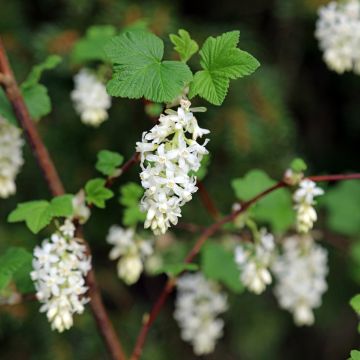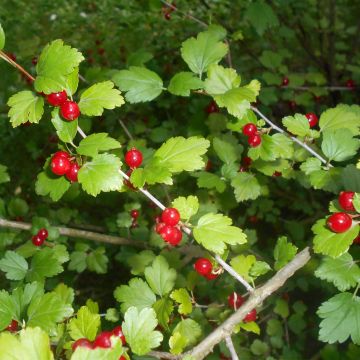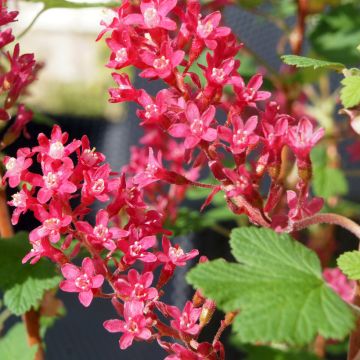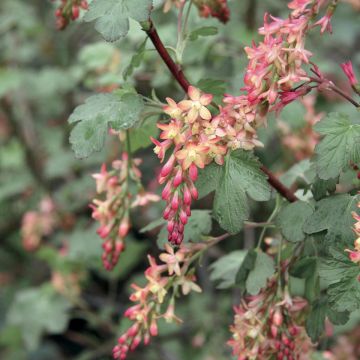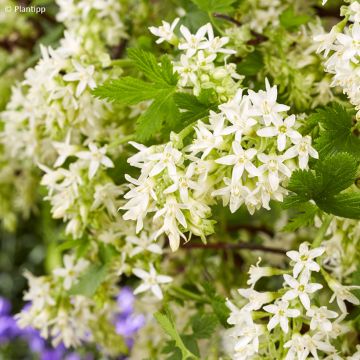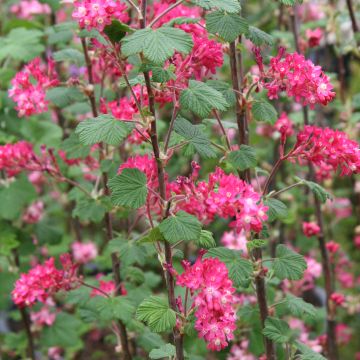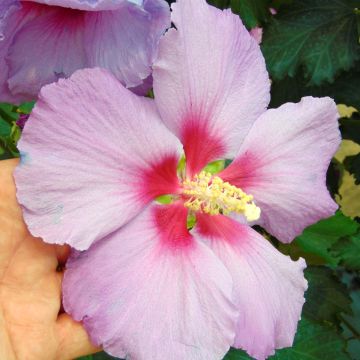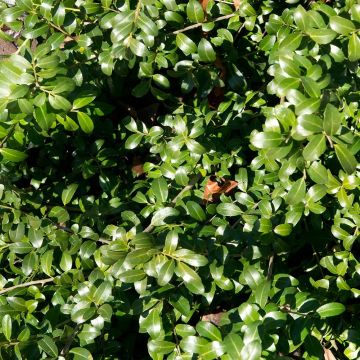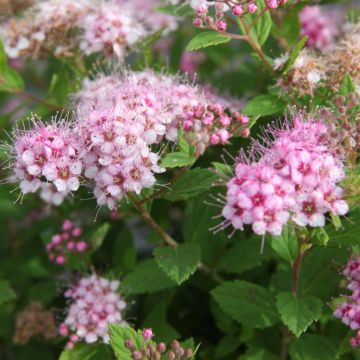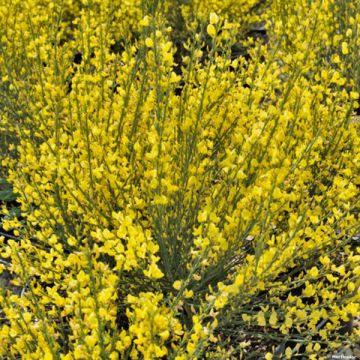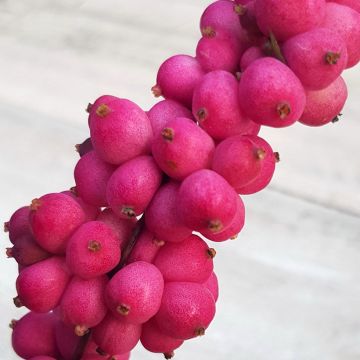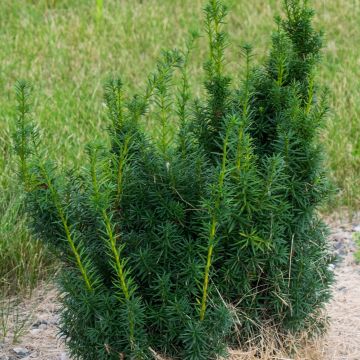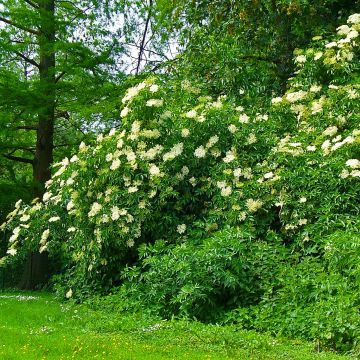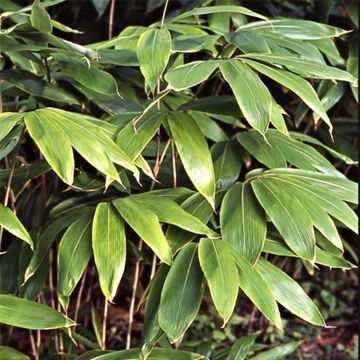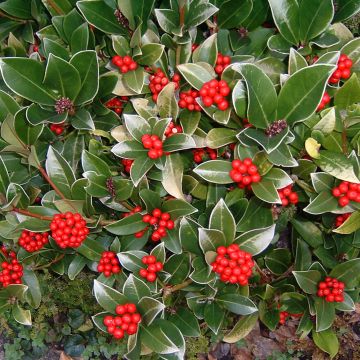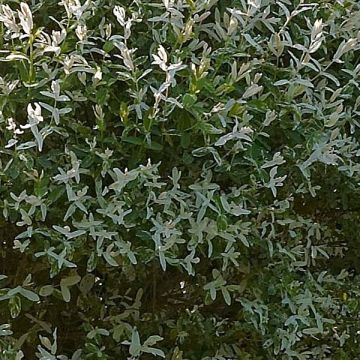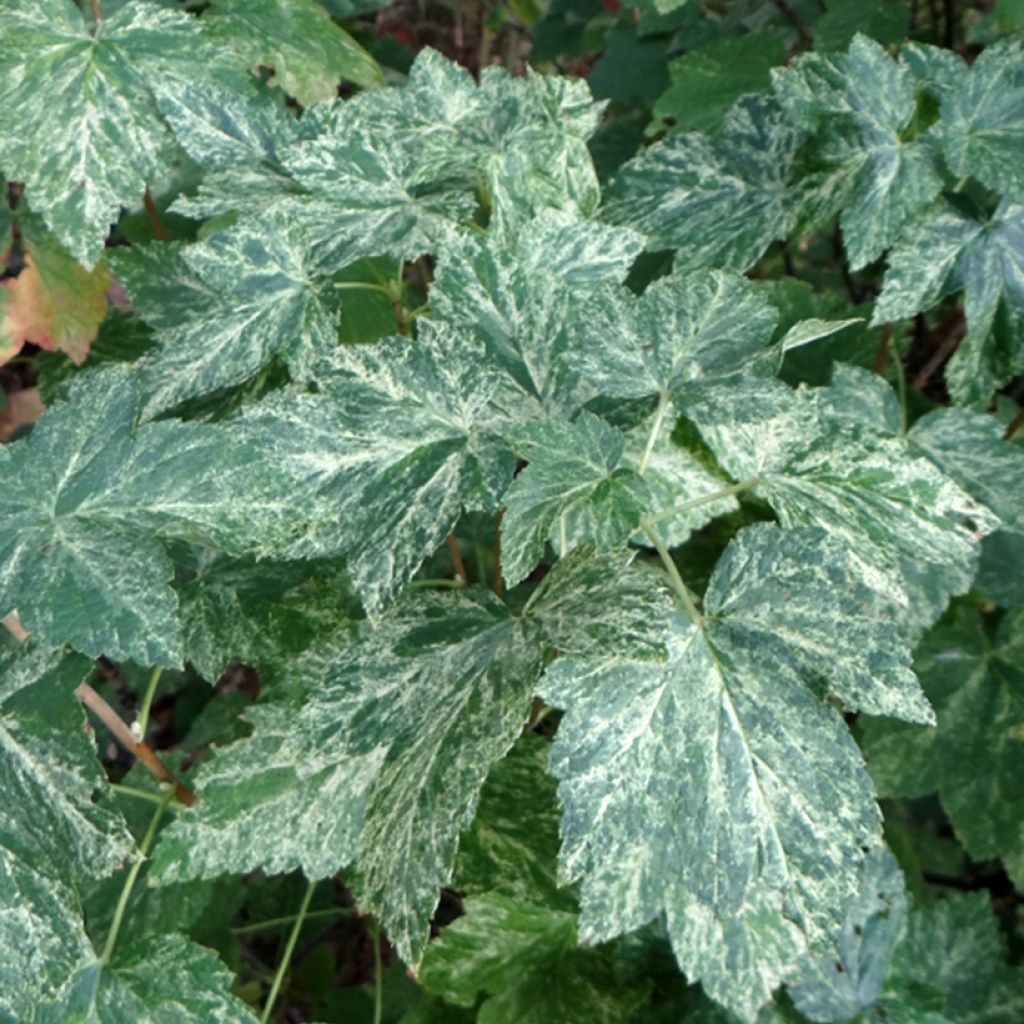

Ribes americanum Variegatum
Ribes americanum Variegatum
Ribes americanum Variegatum
American Black Currant, Eastern Black Currant
This plant carries a 24 months recovery warranty
More information
We guarantee the quality of our plants for a full growing cycle, and will replace at our expense any plant that fails to recover under normal climatic and planting conditions.
From €5.90 for pickup delivery and €6.90 for home delivery
Express home delivery from €8.90.
Does this plant fit my garden?
Set up your Plantfit profile →
Description
Ribes americanum Variegatum is an American blackcurrant bush also known as American Gooseberry. This form has beautiful variegated foliage, delicate and splashed with white. It develops a bushy habit, with a spreading, deciduous growth and spring flowering in pendulous clusters of delicately scented yellow flowers, followed in summer, between June and August, by the formation of edible black fruits. Hardy to -20°C, it willingly settles in partial shade to highlight its foliage, which is also very aromatic, and protect it from the scorching sun. Rich in vitamin C, its fruit also contains anthocyanin pigments, useful for vision disorders.
Ribes americanum or blackcurrant or black gooseberry belongs to the Grossulariaceae family. This species is native to North America where it is found in the states of New Brunswick, Delaware, Virginia, Indiana, Iowa, Nebraska, Colorado, and New Mexico. The Variegatum variety forms a very dense deciduous bush that has dense vegetation, with a bushy and spreading habit and reaches an average height of 1.80m to 2m in all directions at maturity. The hairy young shoots evolve into thornless branches. In April-May, after the leaves have emerged, pendulous clusters of numerous small yellow flowers with a slight fragrance appear. The flowers are followed in summer by small cylindrical black fruits. The foliage develops early in spring. The light green to pure green leaves, measure 5 to 7 cm and are composed of 3 to 5 toothed lobes, with a pleasant odour. They take on a beautiful red and yellow colouration in autumn.
Plant Ribes americanum Variegatum in ordinary, deep, even limestone, rich and moist soil. Note that this American species is quite tolerant to drought. This variegated variety thrives in partial shade. This blackcurrant bush finds a place in all gardens, in an informal or countryside hedge, shrub borders or even as a standalone plant. Create an edible hedge by mixing your favourite small fruits along the vegetable garden border. Even though it is a nourishing bush, you can plant it in a flower bed with shrubs that bloom in spring like Lilacs, mock oranges, Deutzias, and some perennials like Japanese Anemones that bloom at the same time as it bears fruit. Plant some heucheras with various colours at its base, in harmony with its autumn foliage. Finally, to fully enjoy its flowers and fragrance, you can cut budding branches that will bloom in a vase in the house.
Report an error about the product description
Plant habit
Flowering
Foliage
Botanical data
Ribes
americanum
Variegatum
Grossulariaceae
American Black Currant, Eastern Black Currant
North America
Other Ribes - Flowering Currants
Planting and care
Plant Ribes americanum Variegatum in ordinary, deep, even limestone, rich and moist soil. This bush will thrive in partial shade. Pruning is not necessary, except to remove dead wood or correct a slightly sparse habit. The branches can be cut back by one-third of their size after flowering. When planting, you can bury part of the collar to promote good rooting.
Planting period
Intended location
Care
This item has not been reviewed yet - be the first to leave a review about it.
Hedge shrubs
Haven't found what you were looking for?
Hardiness is the lowest winter temperature a plant can endure without suffering serious damage or even dying. However, hardiness is affected by location (a sheltered area, such as a patio), protection (winter cover) and soil type (hardiness is improved by well-drained soil).

Photo Sharing Terms & Conditions
In order to encourage gardeners to interact and share their experiences, Promesse de fleurs offers various media enabling content to be uploaded onto its Site - in particular via the ‘Photo sharing’ module.
The User agrees to refrain from:
- Posting any content that is illegal, prejudicial, insulting, racist, inciteful to hatred, revisionist, contrary to public decency, that infringes on privacy or on the privacy rights of third parties, in particular the publicity rights of persons and goods, intellectual property rights, or the right to privacy.
- Submitting content on behalf of a third party;
- Impersonate the identity of a third party and/or publish any personal information about a third party;
In general, the User undertakes to refrain from any unethical behaviour.
All Content (in particular text, comments, files, images, photos, videos, creative works, etc.), which may be subject to property or intellectual property rights, image or other private rights, shall remain the property of the User, subject to the limited rights granted by the terms of the licence granted by Promesse de fleurs as stated below. Users are at liberty to publish or not to publish such Content on the Site, notably via the ‘Photo Sharing’ facility, and accept that this Content shall be made public and freely accessible, notably on the Internet.
Users further acknowledge, undertake to have ,and guarantee that they hold all necessary rights and permissions to publish such material on the Site, in particular with regard to the legislation in force pertaining to any privacy, property, intellectual property, image, or contractual rights, or rights of any other nature. By publishing such Content on the Site, Users acknowledge accepting full liability as publishers of the Content within the meaning of the law, and grant Promesse de fleurs, free of charge, an inclusive, worldwide licence for the said Content for the entire duration of its publication, including all reproduction, representation, up/downloading, displaying, performing, transmission, and storage rights.
Users also grant permission for their name to be linked to the Content and accept that this link may not always be made available.
By engaging in posting material, Users consent to their Content becoming automatically accessible on the Internet, in particular on other sites and/or blogs and/or web pages of the Promesse de fleurs site, including in particular social pages and the Promesse de fleurs catalogue.
Users may secure the removal of entrusted content free of charge by issuing a simple request via our contact form.
The flowering period indicated on our website applies to countries and regions located in USDA zone 8 (France, the United Kingdom, Ireland, the Netherlands, etc.)
It will vary according to where you live:
- In zones 9 to 10 (Italy, Spain, Greece, etc.), flowering will occur about 2 to 4 weeks earlier.
- In zones 6 to 7 (Germany, Poland, Slovenia, and lower mountainous regions), flowering will be delayed by 2 to 3 weeks.
- In zone 5 (Central Europe, Scandinavia), blooming will be delayed by 3 to 5 weeks.
In temperate climates, pruning of spring-flowering shrubs (forsythia, spireas, etc.) should be done just after flowering.
Pruning of summer-flowering shrubs (Indian Lilac, Perovskia, etc.) can be done in winter or spring.
In cold regions as well as with frost-sensitive plants, avoid pruning too early when severe frosts may still occur.
The planting period indicated on our website applies to countries and regions located in USDA zone 8 (France, United Kingdom, Ireland, Netherlands).
It will vary according to where you live:
- In Mediterranean zones (Marseille, Madrid, Milan, etc.), autumn and winter are the best planting periods.
- In continental zones (Strasbourg, Munich, Vienna, etc.), delay planting by 2 to 3 weeks in spring and bring it forward by 2 to 4 weeks in autumn.
- In mountainous regions (the Alps, Pyrenees, Carpathians, etc.), it is best to plant in late spring (May-June) or late summer (August-September).
The harvesting period indicated on our website applies to countries and regions in USDA zone 8 (France, England, Ireland, the Netherlands).
In colder areas (Scandinavia, Poland, Austria...) fruit and vegetable harvests are likely to be delayed by 3-4 weeks.
In warmer areas (Italy, Spain, Greece, etc.), harvesting will probably take place earlier, depending on weather conditions.
The sowing periods indicated on our website apply to countries and regions within USDA Zone 8 (France, UK, Ireland, Netherlands).
In colder areas (Scandinavia, Poland, Austria...), delay any outdoor sowing by 3-4 weeks, or sow under glass.
In warmer climes (Italy, Spain, Greece, etc.), bring outdoor sowing forward by a few weeks.

































